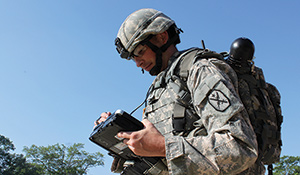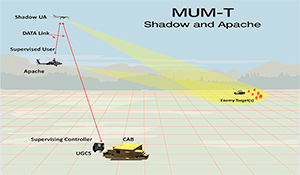
By COL Thomas von Eschenbach
 One of the earliest examples of manned and unmanned teaming, now referred to as MUM-T, was during World War II when a B-17 Flying Fortress took off from RAF Fersfield in England headed to Germany closely followed by three chase aircraft. The B-17, designated a BQ-8 robot, was actually a flying bomb with 20,000 pounds of explosives on board designed with the intent of being remotely piloted into a submarine bunker in Germany. The BQ-8 concept was to launch like a normal aircraft with two pilots, reach a cruise altitude of 2,000 feet, arm the explosives, and then have the crew parachute into the English Channel while the rest of the mission would be flown remotely by one of the chase aircraft. Although the mission ultimately failed, the concept and benefits of MUM-T, along with the technology to execute these types of operations, continue to mature and take hold in concepts of how the U.S. Army could execute improved unified land operations.
One of the earliest examples of manned and unmanned teaming, now referred to as MUM-T, was during World War II when a B-17 Flying Fortress took off from RAF Fersfield in England headed to Germany closely followed by three chase aircraft. The B-17, designated a BQ-8 robot, was actually a flying bomb with 20,000 pounds of explosives on board designed with the intent of being remotely piloted into a submarine bunker in Germany. The BQ-8 concept was to launch like a normal aircraft with two pilots, reach a cruise altitude of 2,000 feet, arm the explosives, and then have the crew parachute into the English Channel while the rest of the mission would be flown remotely by one of the chase aircraft. Although the mission ultimately failed, the concept and benefits of MUM-T, along with the technology to execute these types of operations, continue to mature and take hold in concepts of how the U.S. Army could execute improved unified land operations.
The tremendous amount of time, effort, and resources expended on Army MUM-T research and development have grown exponentially in the past two decades forcing not only unmanned systems to evolve in their employment but also driving inclusion of MUM-T capabilities in our manned aircraft design requirements and integrated base design. For example, currently the AH-64D Apache has the capability to control an unmanned aircraft (UA) and its payload utilizing an add-on system designated MUM-T2; the design of the AH-64E will possess capabilities to not only control the payload but also control the flight of the UAS and will have a MUM-T capability fully integrated into the aircraft human-machine interface during production.
As the US Army takes the lessons learned and best practices from the past decade plus of conflict, partnerships between the TRADOC Capabilities Managers for UAS and Recon/Attack along with program managers from the Program Executive Office (PEO) Aviation, continue to develop and integrate new ways to increase capabilities without task saturating aircrew members. Today MUM-T isn’t just conducting attack, recon and surveillance operations but also includes signals intelligence and distributing sensor data to Soldiers on the ground. Tomorrow MUM-T could extend to aerial delivery of cargo as well.
Real-time Intel Enroute and Beyond
 The One System Remote Video Terminal (OSRVT) can not only be a great tool for the Soldier maneuvering on the ground by providing situational awareness to the most vulnerable, but can also provide real time information to ground forces aboard a UH-60 Blackhawk or CH-47 Chinook enroute to an objective during an air assault mission. OSRVT also provides aircrews with real time video of the landing/pick-up zone (LZ/PZ) at 15 to 20 kilometers prior to arrival. This capability can continue to provide video to the Soldiers once on the ground due to the portability of the OSRVT system. The -50 OSRVT, which starts fielding in FY15, will provide the ability for Soldiers to request control of the UA electro-optical/infrared (EO/IR) payload sensors, giving them the ability to select specific areas of interest. MUM-T development is not only providing the Soldier on the ground a tremendous advantage in situational awareness but it’s also compressing the timeline of sensor to shooter or sensor to action due to the accuracy of the information provided by real time video.
The One System Remote Video Terminal (OSRVT) can not only be a great tool for the Soldier maneuvering on the ground by providing situational awareness to the most vulnerable, but can also provide real time information to ground forces aboard a UH-60 Blackhawk or CH-47 Chinook enroute to an objective during an air assault mission. OSRVT also provides aircrews with real time video of the landing/pick-up zone (LZ/PZ) at 15 to 20 kilometers prior to arrival. This capability can continue to provide video to the Soldiers once on the ground due to the portability of the OSRVT system. The -50 OSRVT, which starts fielding in FY15, will provide the ability for Soldiers to request control of the UA electro-optical/infrared (EO/IR) payload sensors, giving them the ability to select specific areas of interest. MUM-T development is not only providing the Soldier on the ground a tremendous advantage in situational awareness but it’s also compressing the timeline of sensor to shooter or sensor to action due to the accuracy of the information provided by real time video.
Future Force Structure
The future organizational force structure of Army Aviation has been shaped by MUM-T advantages. This was accomplished by placing organic Shadow and Gray Eagle formations in the combat aviation brigades (CABs), increasing the UAS operators’ recon and attack capabilities, and expanding gunnery requirements with their manned team members. A series of the Army’s Hellfire missile, the AGM-114R/R2, was developed to accommodate the increased engagement altitude of the UAS as well as many other capabilities being pursued by TCM-UAS and Program Management Office-Unmanned Aircraft Systems (PMO-UAS) as technology and funding allows.
The amount and pace of MUM-T observations, insights and lessons learned compiled over the last 10 years can be daunting. The ability to sort through the amount of information available would be extremely time-consuming for units, which is why TCM-UAS is developing a MUM-T handbook through a multi organizational collaborative effort. The Handbook is a quick reference guide of best practices proven over the years. It will also serve as a baseline source of information for commanders and their staff to develop a common understanding of MUM-T that can be customized to their current operation based on mission, enemy, terrain and weather, troops, time available and civil (METT-TC) criteria.
Training Strategy
Although much work is being done on increasing our MUM-T technologies, our increase in capability will not be possible without the proper training strategies. MUM-T can and will be trained in simulation and is incorporated into manned and unmanned mission simulators, to include the teaming of the Universal Mission Simulator (UMS) with the Aviation Combined Arms Tactical Trainer (AVCATT) for inclusion into the Integrated Training Environment (ITE).
 USAACE is leading an integrated project team directed by Headquarters, Department of the Army to identify MUM-T collective training strategies that will include UAS assigned to the National Training Center with tactics, techniques, and procedures (TTP) development and collection oversight. MUM-T is also being included in the Army’s professional military education (PME) system for leaders to ensure successful air/ground integration occurs across our formations. Force-on-force capabilities are being developed to fully integrate MUM-T training opportunities at combat training centers, home station training, and in simulation. Force-on-target training opportunities are emerging with the advent of the Digital Air Ground Integration Range (DAGIR) and Digital Range Training System (DRTS).
USAACE is leading an integrated project team directed by Headquarters, Department of the Army to identify MUM-T collective training strategies that will include UAS assigned to the National Training Center with tactics, techniques, and procedures (TTP) development and collection oversight. MUM-T is also being included in the Army’s professional military education (PME) system for leaders to ensure successful air/ground integration occurs across our formations. Force-on-force capabilities are being developed to fully integrate MUM-T training opportunities at combat training centers, home station training, and in simulation. Force-on-target training opportunities are emerging with the advent of the Digital Air Ground Integration Range (DAGIR) and Digital Range Training System (DRTS).
As the Army looks towards the Force 2025 and beyond concept to maintain its overmatch against a wide range of adversaries in the next decade, UAS employment will have to continue to expand its roles and missions. As this takes place over the coming years, we will need to explore the full range of the capabilities of the UAS and how they can bring synergy to a smaller, leaner Army in a more expeditionary, lethal and survivable manner.
COL Thomas von Eschenbach is the U.S. Army Training and Doctrine Command (TRADOC) Capabilities Manager for Unmanned Aircraft Systems, located at Fort Rucker, AL.
Caption1: Portability of the One System Remote Video Terminal (OSRVT) system provides before, during and after insertion capability to the ground Soldier.
Caption2: An RQ-7 Shadow unmanned aircraft system and Apache prepare to launch on a mission in Iraq.
Credits: U.S. ARMY PM AW GRAPHIC
Credit: TCM UAS COURTESY PHOTO







